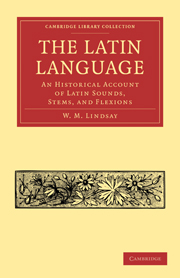Book contents
- Frontmatter
- PREFACE
- Contents
- LIST OF ABBREVIATIONS
- CHAPTER I THE ALPHABET
- CHAPTER II PRONUNCIATION
- CHAPTER III ACCENTUATION
- CHAPTER IV THE LATIN REPRESENTATIVES OF THE INDO-EUROPEAN SOUNDS
- CHAPTER V FORMATION OF NOUN AND ADJECTIVE STEMS
- CHAPTER VI DECLENSION OF NOUNS AND ADJECTIVES. COMPARISON OF ADJECTIVES. NUMERALS
- CHAPTER VII THE PRONOUNS
- CHAPTER VIII THE VERB
- CHAPTER IX ADVERBS AND PREPOSITIONS
- CHAPTER X CONJUNCTIONS AND INTERJECTIONS
- INDEX
- ADDENDA ET CORRIGENDA
CHAPTER VI - DECLENSION OF NOUNS AND ADJECTIVES. COMPARISON OF ADJECTIVES. NUMERALS
Published online by Cambridge University Press: 05 August 2011
- Frontmatter
- PREFACE
- Contents
- LIST OF ABBREVIATIONS
- CHAPTER I THE ALPHABET
- CHAPTER II PRONUNCIATION
- CHAPTER III ACCENTUATION
- CHAPTER IV THE LATIN REPRESENTATIVES OF THE INDO-EUROPEAN SOUNDS
- CHAPTER V FORMATION OF NOUN AND ADJECTIVE STEMS
- CHAPTER VI DECLENSION OF NOUNS AND ADJECTIVES. COMPARISON OF ADJECTIVES. NUMERALS
- CHAPTER VII THE PRONOUNS
- CHAPTER VIII THE VERB
- CHAPTER IX ADVERBS AND PREPOSITIONS
- CHAPTER X CONJUNCTIONS AND INTERJECTIONS
- INDEX
- ADDENDA ET CORRIGENDA
Summary
§ 1. I. DECLENSION OF NOUNS AND ADJECTIVES. The I.-Eur. Noun had three Genders, Masc., Fem., and Neut., three Numbers, Sing., Dual, and Plur., and at least eight Cases, Nom., Gen., Dat., Acc., Voc. (if the Voc. may be called a Case), Abl., Instrumental, and Locative (the Dat., Abl., Instr., Loc. are not always easy to discriminate in the Plural). The three Genders are retained in Latin, but of the Numbers the Dual has disappeared, though traces of it remain in the Numeral forms duō (§ 59), octō (lit. ‘two sets of four’?), and in the Pronoun form ambō (ch. vii. § 29). (On vī-gintī, see § 74.) Of the Cases the Voc. hardly survives except in O-stems (§ 31), and the Instr. has left only doubtful traces of itself in some Adverb forms (§ 36); the Locative became by the operation of the phonetic laws of the language indistinguishable in Ā-stems from the Gen. Sg., while in O-stems it seems to have ousted the Genitive (§ 17), and in Cons.-stems the Ablative (§ 33).
The I.-Eur. Cases were indicated sometimes by the addition of suffixes, e.g. -s for Nom. Sg. Masc., -m for Acc. Sg., sometimes by modification of the stem, e. g. *pӑtēr Nom. Sg. of stem *pӑtĕr-, ‘a father,’ sometimes by both, e. g. *patr-ŏs, *patr-ōm Gen. Sg., Pl. of the same stem.
- Type
- Chapter
- Information
- The Latin LanguageAn Historical Account of Latin Sounds, Stems, and Flexions, pp. 366 - 420Publisher: Cambridge University PressPrint publication year: 2010First published in: 1894



